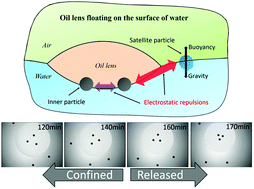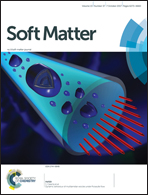Electrostatic interactions between particles through heterogeneous fluid phases†
Abstract
We investigated the electrostatic interactions between particles acting through heterogeneous fluid phases. An oil lens system floating on the surface of water was used to trap particles at different fluid–fluid interfaces. The inner particles are located at the centrosymmetrically curved oil–water interface inside the oil lens while satellite particles are located at the curved air–water interface, separated by a particular distance from the triple phase boundary. The satellite particles are likely to be captured in an energy minimum state due to electrostatic repulsions by the inner particles balanced with the gravity-induced potential energy. As the size of the oil lens decreases upon evaporation, the satellite particles escape from the gravitational confinement at a critical moment. The self-potential values of the inner particles and the satellite particles were calculated by employing an energy balance and the experimentally obtained geometric parameter values. It was found that the self-potential values of the inner particles decrease as oil evaporates over time and that the magnitude of the self-potential of the satellite particles is a hundred times larger than that of the inner particles. These results demonstrate significant effects of the thickness and shape of the nonpolar superphase on the electrostatic interactions between the particles trapped at different fluid–fluid interfaces.



 Please wait while we load your content...
Please wait while we load your content...